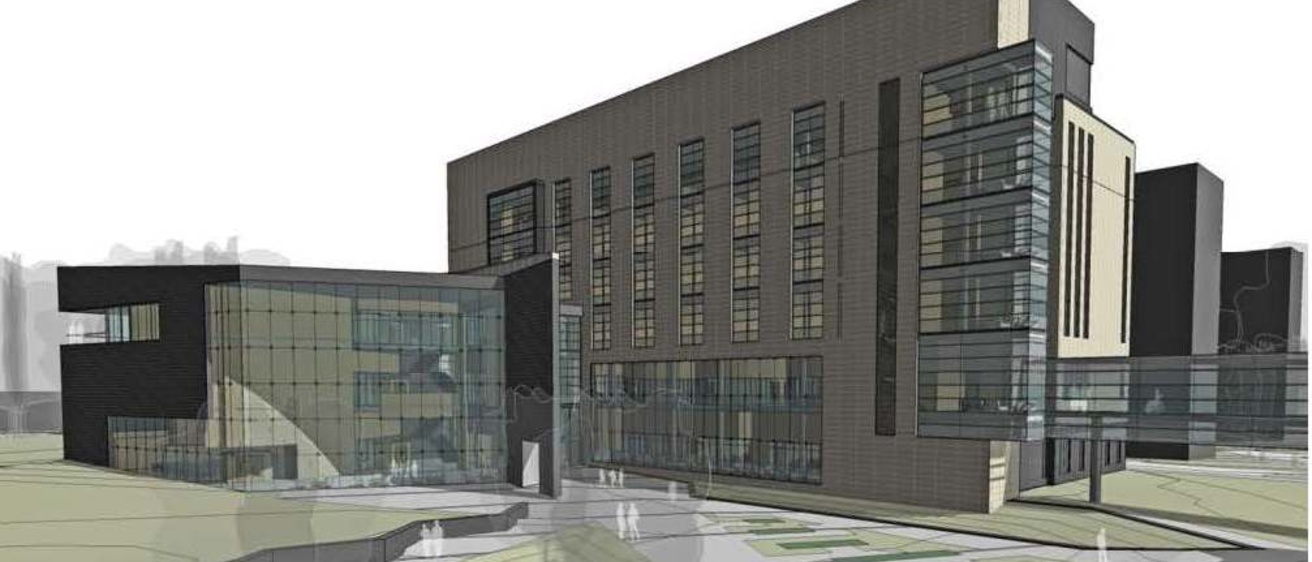Donald Letendre, dean of the University of Iowa College of Pharmacy, says educating the next generation of leaders in pharmacy practice and pharmaceutical science takes more than a rigorous curriculum delivered by top-notch faculty and staff.
It also requires a state-of-the-art facility.
On Thursday, Sept. 29, the UI will officially break ground on a new $96.3 million pharmacy building that will feature cutting-edge research laboratories, innovative technology, and collaborative learning spaces.
Letendre says the new high-tech facility will complement the college’s new curriculum and help the UI secure its place as one of the nation’s elite pharmacy programs.
“This new building will provide us with the opportunity to deliver an avant-garde curriculum that takes advantage of contemporary technology and to use new pedagogies that are centered on enhancing the student experience and creating an environment of community,” he says. “On the scientific side, it will provide an environment in which our scientists won’t be limited in their quest for new knowledge.”
The groundbreaking ceremony will take place from 3:30 to 4:30 p.m. at the College of Pharmacy.
The new pharmacy building is being constructed across the street from the current facility at the former site of Quadrangle Hall, which was demolished this summer. Most of the existing pharmacy facilities, built in 1961, will be taken down, though the south tower, built in 1996, will remain.
The new building will be almost twice the size of the current one, with 296,000 square feet of space, says Jen Hoffman, project manager for the UI Office of Planning, Design and Construction. It is expected to open by early 2020 and will incorporate a variety of strategies to promote universal design, a concept that recognizes and attempts to accommodate the broadest possible spectrum of human ability.
“We will be, without question, the envy of our peers once this building is done,” Letendre says. “What this project is doing in terms of boosting morale is almost immeasurable for our staff and faculty.”
Among the new building’s many features will be:
- Twenty-three learning spaces, including classrooms, lecture halls, and conference and seminar rooms—10 more than in the current building
- A 128-seat, team-based learning lecture hall with three 220-inch projection screens and space to allow students to collaborate in teams
- Sixteen laboratory-science research spaces, five more than in the existing facility
- A Pharmacy Practice Learning Center that includes a mock hospital pharmacy and a mock community pharmacy
- Elements of universal design, including built-in hearing loops in some of the spaces that will broadcast directly to a person’s hearing device. Each floor will have an associated color to help visitors find their way.
Jay Currie, chair of the Department of Pharmacy Practice and Science, says he looks forward to teaching in the new spaces, especially the Pharmacy Practice Learning Center.
“Instead of telling our students ‘Let’s make believe we are in a community pharmacy’ or ‘Let’s make believe we are in a hospital pharmacy,’ we will have the real thing,” he says. “They will get a chance to practice in an environment where their later rotations will actually happen.”
Gary Milavetz, associate professor of pharmacy and head of the Division of Applied Clinical Sciences, says the new building will enhance faculty research and allow for more meaningful interactions with students.
“The lack of teaching spaces and arrangement of classrooms in our current physical environment limits active learning by students and minimizes student–faculty interactions,” he says.
Susan Vos, a clinical associate professor in the Department of Pharmacy Practice and Science, says faculty offices will be more accessible to students who also will have more space to study alone or in small groups.
“I am excited about being able to see students working, studying, and learning in our building, rather than seeing them leave to find space in other buildings on campus,” she says.
Letendre says having a new building will help retain and recruit high-quality faculty, staff, and students and inspire new discoveries.
“Our limits today are not brain power or creativity. Our limits are, quite frankly, our physical plant,” Letendre says. “We will be liberated by our new facilities.”
Editor’s note: The University of Iowa will celebrate the groundbreaking of the new UI College of Pharmacy building at 3:30 p.m., Thursday, Sept. 29. For details about that event and the coming dedication and open house events for the University of Iowa’s new Visual Arts Building and Voxman Music Building, visit inspire.uiowa.edu.
